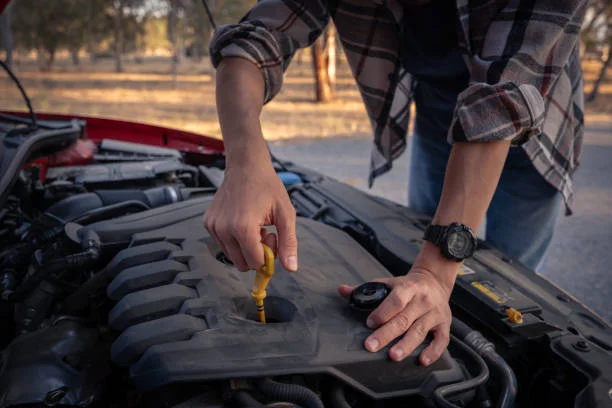When it comes to vehicle maintenance, one of the most essential tasks is checking engine oil regularly. Engine oil is very important in maintaining your car engine in an efficient condition since it helps to lubricate its inner parts, reduce frictions and overheating of the engine. Failure to have an adequate or the correct kind of oil may damage your engine seriously, and the repairs may cost you a fortune or more likely result in an engine breakdown.
However, many car owners neglect the importance of oil maintenance, either forgetting to check oil levels or failing to recognize signs of oil degradation. It is a fairly fine but necessary task that can be performed in a few minutes, prolonging the life of your car and making it perform better as well.
This guide will show you exactly how you can go about checking your engine oil, indications that the oil needs to be replaced and some pointers on how to ensure that your oil level is at the desired level. Whether you’re a first-time car owner or an experienced driver, understanding how to properly check oil levels is a vital skill that will ensure your car runs smoothly for years to come.
Why Is It Important to Check Engine Oil?
One of fastest but easiest ways of keeping your car running at its highest peak is to check your engine oil on a regular basis. The engine oil of your car is its blood and it plays a number of important roles:
Lubrication: It is important to help move the internal components of your engine, components like pistons, valves and camshafts that would otherwise become too hot in the presence of excessive friction. This minimizes friction and eliminates unhealthy wear and tear of these parts.
Cooling: Your engine runs through some considerable quantity of heat. This heat is absorbed and dissipated by engine oil, which aims at avoiding overheating of the engine and possible damages.
Cleaning: Oil assists in the removal of smoke, dust and dirt particles in the engine leaving it clean and efficient. A failure to perform routine oil changes and inspection of the level may result in the accumulation of contaminants that damage engine parts.
Avoids Rust and Corrosion: Oil seals rust and corrosion. Due to the frequency of the oil check, you are also avoiding the case of moisture building up in the engine, which will eventually lead to corrosion of metal parts.
Failing to check your engine oil regularly can lead to low oil levels, which may cause poor engine performance, overheating, and even severe engine damage. If you always perform oil checks in the course of your car maintenance, your engine will last longer, your car will continue to perform optimally and will reduce costs of conducting expensive repairs.
Explore related articles to deepen your understanding before you go.
How Often Should You Check Your Engine Oil?
How often you check your engine oil varies on a number of conditions such as the make model of your car, driving conditions and how you use your oil. As a general rule, it’s recommended to check your engine oil every 1,000 to 1,500 miles, or at least once a month. Others, however, may be equipped with an oil-monitoring device and warn you when the oil should be checked or replaced. Under this situation, you are able to consider manufacturer recommendations of your car.
A number of factors know to determine how regularly you might want to test your oil:
- Driving Conditions: Drive in extreme tempers, stop and go traffic, dusty areas would be some of the harsh conditions under which you may have to check up on your oil frequently. Such circumstances may lead to the rapid disintegration of the oil and its diminished performance.
- Type of oil: The kind of oil that you use also determines the frequency with which your oil levels should be checked. Synthetic oils typically last longer than conventional oils, so you may be able to go longer between checks and changes. Never use the mileage in the manual to change car oil.
- Old Engines: You can check the car more often, when it is an old car, there is more likely to burn oil fast and you do not want to run on very little oil.
By sticking to a regular oil check routine, you ensure your engine is properly lubricated and avoid issues like low oil pressure or overheated engines.
Tools You’ll Need to Check Engine Oil
Inspecting the engine oil is so simple that it takes only a few simple tools and a couple of minutes. These are the documents you will require to have in order to make the process easy and correct:
- Oil Dipstick: This is the most important gadget you have to use to monitor the level of your oil. A dipstick is usually bright-colored (yellow or orange) and it tends to be near the engine of a most cars. That is in case your car does not have a dipstick, newer ones may have an electronic oil gauge, which gives oil level readings.
- Clean Rag or Towel: You will require a clean rag or a towel to clean the dipstick between use. This will give the correct readings and keeps your hands clean.
- Funnel (Optional): You should put this on the corner of the area where you want to top-up your oil and with the funnel you will not spill the oil and it would automatically go to oil reservoir.
- Gloves (Optional): You may like to wear gloves in case you are worried about filth because your engine can be hot, so oils can be somewhat greasy and messy.
- Flashlight (Optional): A flashlight should be used only when you are inspecting the oil level in an area that is not properly lit up as it would allow you to see the oil level and marking of the dipstick easily.
This will enable easy checking of your engine oil without complications, since you will have these tools at hand.
Loved this post? You’ll find even more just like it on our blog!
How to Check Engine Oil: Step-by-Step Guide
Verifying you engine oil is a simple and indispensable action all the car owners ought to be familiar with. These are easy steps to take in order to ensure that your engine oil is at the correct level and is in good condition:
1. Warm Up Your Engine
It is important to note that by the time of checking the oil, you should start the engine, and allow it to run a few minutes. This will loosen the oil and it will be easy to tell the exact reading because the oil is warmed up. Shut the engine and leave it idle, say, a minute or two.
2. Locate the Oil Dipstick
Open the hood of your car and check on oil-dipstick. The dipstick is usually a long thin metallic rod which has a brightly colored handle usually yellow or orange. Your car model may differ in the position of the dipstick, and thus, you can use your car manual when you have difficulties in locating the dipstick.
3. Remove and Clean the Dipstick
Pick the dipstick once identified and slowly, gently pull it out. Clean a clean rag and wipe the oil that might be on the dipstick. This will make sure that upon reinserting it you will get a proper reading.
4. Reinsert the Dipstick
Bring the cleaned dipstick back to the tube to the end. Ensure that this is fully inserted because when it is not, incomplete insertion is likely to lead to inaccurate results.
5. Pull Out the Dipstick and Check the Oil Level
Put back the dipstick then re-remove it and measure the oil level. On the dipstick, there ought to be two marks as the lowest mark and the highest mark. The oil should be between these two marks.
- If the oil is at or near the minimum level, it’s time to add oil.
- If the oil is at the maximum level, you’re good to go.
Additionally, check the color of the oil.. Ambers or light brown oil should be clean. When it is dark brown or black, then it could mean that the oil is contaminated and actually should be exchanged.
6. Top Up Oil (If Needed)
Probably, you will end up adding engine oil to your vehicle. To accomplish this, place the oil filler cap (normally marked with a symbol that looks like oil or an oil can) and take it out. Put the proper quantity of oil as recommended by the manufacturer of your vehicle using a funnel. When adding oil, then do it sparingly and monitor the status regularly to prevent overfilling.
7. Replace the Dipstick and Close the Hood
After ensuring that the level of the oil matches the correct level, put back the dipstick and close the hood of your car firmly. Check that all is well sealed to avoid any leakages and contamination.
What to Do If Your Oil Level Is Low
In case you notice that there is low engine oil, then you should work on it and ensure that you do not allow damage of your engine. Low oil levels can cause your engine to run dry, which leads to increased friction, overheating, and ultimately, expensive repairs. This is how to deal with it:
Safe Add Oil
When the amount of oil is not sufficient to touch the minimum mark of the dipstick then, you should add engine oil to your engine. Make sure you come up with the right type of oil of your car. For those uncertain about the right oil for their engine, Moto Craz provides a helpful guide to choosing the right oil grade based on your car’s make and model. Adding oil is a simple task — just use a funnel to carefully pour oil into the oil filler cap, and make sure to add it gradually. With any little top-up, always recheck the level to ensure one does not overfill it.
Leakage Check-up
When the oil level keeps on depleting despite filling it, you might be having an oil leak. Look at the parking lot before you park there and make sure that there are no oil spills. When you realize that you have them then you should have your car checked by a mechanic to avoid problems.
Schedule an Oil Change
If your oil is low and appears dirty or degraded, it might be time for an oil change. Keeping track of your oil change intervals is essential to maintaining the health of your engine. Regular oil changes ensure that your engine stays properly lubricated and clean, minimizing the chances of oil-related problems.
Take A Look At The State of Your Second-Hand Vehicle
When the car is used, ensure that you check the oil more frequently, especially when it comes to used cars. A second hand vehicle might have old engine components or might be having some other problems that might trigger high oil burns. It’s a good idea to ask about the car’s oil maintenance history before purchasing, and make sure to follow a regular oil-checking routine after buying the vehicle.
By addressing low oil levels promptly and maintaining good oil practices, you’ll ensure that your engine stays healthy and performs optimally.
Signs You Might Need an Oil Change
Regular oil changes are vital to keeping your engine healthy and running smoothly. Engine oil does not always remain efficient and may even harm the engine when it is not replaced through some period of time. There are several signs you should look out for that indicate it might be time for an oil change.
Among the most frequent signs, there is color of the oil. Engine oil when it is new is clear amber but it turns darker with use. In case the oil is dark brown or even black, it is a tell-tale indication that it has been becoming contaminated so that it now no longer performs its functions of lubricating the engine and cleaning the engine. In addition to this, many vehicles are equipped with an oil change light that will illuminate on your dashboard when it’s time for a change. If this light comes on, it’s an automatic cue to check the oil and schedule an oil change if necessary.
Unusual engine noise is also another indication that the oil has to be changed. If you begin to hear knocking or grinding sounds coming from the engine, it may be due to inadequate lubrication caused by old oil. Similarly, if you notice a burnt oil smell, it suggests that the oil is breaking down and losing its ability to protect your engine from friction and heat.
Finally, excessive smoke from the exhaust or poor engine performance can also point to oil issues. If the oil is low or old, the engine may start burning it, causing visible smoke or strange engine behavior.
Troubleshooting Common Oil Problems
Regarding the engine oil, couple of problems can be met by car owners. Ensuring that you know these problems earlier helps you avoid major engine damages and expensive repair costs. This is how one can troubleshoot some of the most frequent oil-related issues.
Overfilled oil is one of the problems that can involve you. Adding excessive oil to the engine may result in a condition of the oil becoming foamy and as a result the oil will have lesser capacity to lubricate the engine, it may overheat as well. In case you think that your oil level is over the top, then you have to drain out excess oil cautiously. The correct capacity of oil in your car is always given in your cars manual and never use more than what the capacity is.
Leaky oil is the other frequent problem. The oil may be leaking out of the engine in case you find oil stains or puddles beneath your car. Exhaust gas leaks could be the result of the existence of worn-out gaskets, seals, or cracks in the engine block. In case you notice an oil leak, make sure you take your car to a shop to examine and fix it soonest as failure to this may cause more damage to your car, as well as the loss of oil.
The burning of oil is another problem that may occur and especially in old cars. In the event that your engine burns gasoline at a fast rate, it might be because your engine pistons and valves are worn. This can lead to blue smoke from the exhaust. When you realize that your oil sinks in a short duration then you have to consider contacting a professional mechanic to take a look at your engine to establish the cause before coming up with a possible solution.
By taking care of these general oil issues in good time you will be spared more serious predicaments that may jeopardize the condition of your engine.
Conclusion
As simple and yet vital actions, regular inspection and maintenance of your engine oil are some of the few steps towards maintaining the viability and performance of your car. With constant monitoring of oil levels and early fixing of any complications like low oil, dirty oil or potential leakages, you can avoid unnecessary expenses incurred in repairing the engine and have your engine run flawlessly throughout years.
As a new car owner or an experienced driver, it is very necessary that you get into a routine habit of checks and changes of oil to keep your car performance at its best. Remember, if you ever feel unsure about the oil you need or how to maintain it, guides like Moto Craz can help you choose the right oil and offer tips on keeping your engine in top shape.
Engine oil is one investment in the health of your car so that you drive safe and smoothly many miles ahead.
Don’t stop here—take a look at what else we’ve got for you!







